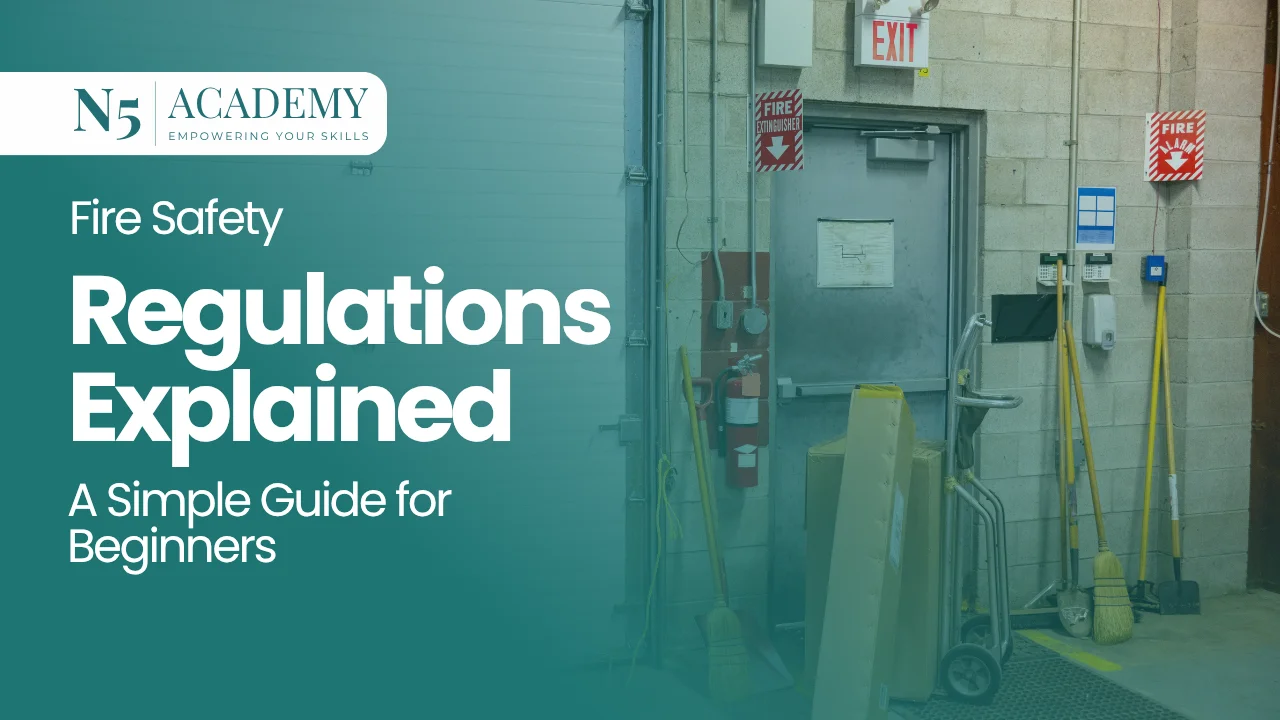

Fire safety is not just a legal requirement; it is a crucial duty to protect lives. If you run a business, manage a property, or want to keep your family safe, understanding fire safety rules is essential. Unfortunately, many people in the UK still do not know the rules they need to follow.
Fires can start and spread fast. A small mistake, like overloading a plug socket or not keeping a fire exit clear, can lead to disaster. Thousands of fires happen each year in the UK, and many can be prevented.
This beginner’s fire safety guide simplifies UK fire safety laws. It explains what you need to do to stay safe and comply with the rules.
At N5 Academy, we have trained hundreds of people through our fire marshal training course, making fire safety easy and practical.
What Are Fire Safety Regulations in the UK?
Fire safety regulations in the UK are laws that aim to lower the risk of fire, protect lives, and ensure safe escape routes during emergencies. These rules apply to various places, such as offices, warehouses, shops, restaurants, and shared areas in apartment buildings.
According to the Regulatory Reform (Fire Safety) Order 2005, anyone responsible for a commercial building or a multi-occupied residential building must:
This law is central to UK fire safety regulations, and understanding it can clarify other related laws. Additional rules, like the Fire Safety (England) Regulations 2022, have been added to enhance safety, especially in tall buildings.
Who is Responsible?
If you’re any of the above, this law applies to you. And even if you’re not, having a working knowledge of these duties can empower you to advocate for safer environments.
Understanding UK fire safety laws can be confusing. Legal documents are often filled with complex language. Let’s simplify some key terms you need to know.
By knowing these terms, you’re ahead of many people learning about fire safety. Each term is important for keeping your workplace safe.
A fire risk assessment is like a report card for your building’s fire safety. It helps you:
Legal Requirement: If you have five or more employees, you must have a written fire risk assessment. Even if you have fewer employees, it’s still a good idea to do one to show your commitment to safety.
Need help? Many people who take our fire safety course say it made the assessment process clearer. While templates are available, getting professional help is often a good investment, especially for larger or more complex locations.
Tip: Update your fire risk assessment every year or right after any changes to the structure, occupancy, or incidents. Keeping your documents up-to-date keeps you safe and compliant.
Having the right equipment is essential, not just for appearances. It’s a legal requirement and can save lives quickly. Choosing the right tools and keeping them in good condition is equally important.
Don’t just install safety equipment; maintain it. Schedule regular testing, servicing, and inspections by qualified professionals. Keep records of all equipment in your fire safety logs.
Train employees on how to use fire extinguishers properly. Different types of fires need specific extinguishers. Our fire marshal training course explains this clearly and includes live demonstrations.
When a fire starts, things can get chaotic. However, clear roles and responsibilities help keep order, allow for quick action, and save lives. Everyone in your building has a role, but the law sets specific expectations for some people.
Tip: For larger teams or multi-floor buildings, assign several fire marshals. Enrol them in a fire safety course to ensure they are legally compliant and confident in emergencies.
Fire hazards exist in every building, such as bad wiring and improperly stored flammable materials. Being aware of these dangers is your first defence, but taking action can prevent disasters.
Our fire safety course uses real-life examples to help staff recognise hidden dangers. It’s always cheaper and safer to prevent problems than to fix them.
Ignoring fire safety rules can result in large fines or even jail time. More than just money and legal issues, the impact on people affected by fire negligence is huge.
In 2023, a restaurant in London was fined £20,000 for several safety issues. Inspectors found blocked fire exits, missing emergency lights, and no fire risk assessment.
Don’t let your business face penalties. Focus on following safety rules, training staff, and reviewing procedures regularly. The fire safety course at N5 Academy can help you improve fire safety in the long run.
Even the best equipment is useless if no one knows how to use it. Training connects knowledge and action.
At N5 Academy, our fire safety course provides:
Best For:
Fire safety inspections by the fire brigade can be planned or unexpected. Being prepared is your best defence and helps you stay safe at all times.
Bonus Tip: Make a detailed fire safety logbook. Include test records, fire marshal appointments, training schedules, maintenance logs, and past inspection reports. This shows professionalism and preparedness.
Managing fire safety can seem overwhelming, but help is here. You don’t have to be an expert right away. There are specialists, guides, courses, and organisations ready to assist you.
If you’re new to UK fire safety laws or need a quick update, there’s always more to learn. Staying proactive is the best choice.
Join our expert-led fire marshal training course and get certified today.
Fire safety is essential, not optional. You now have the knowledge to protect lives and property, from basic concepts to formal training.
Every workplace and home should prioritise fire safety. A small investment in education and preparation today can prevent serious problems in the future.
If you’re ready to act, check out our complete fire safety course to turn this guide into useful skills.
We help you forge a successful career in health and safety. We’re a UK-based company providing top-notch safety training courses that adhere to industry standards.